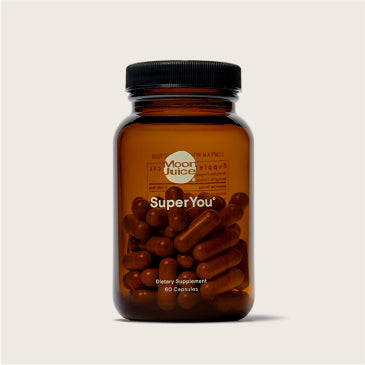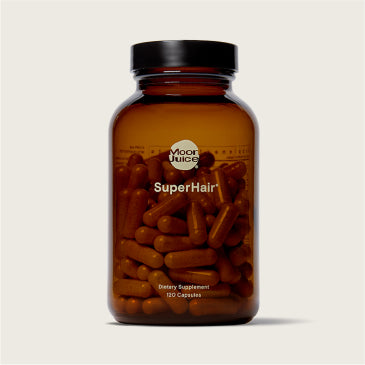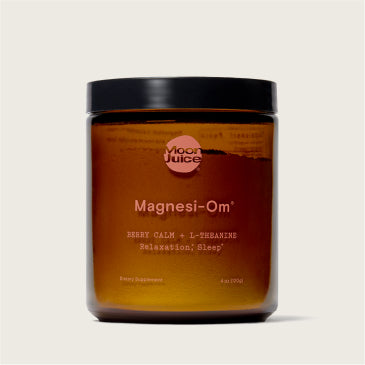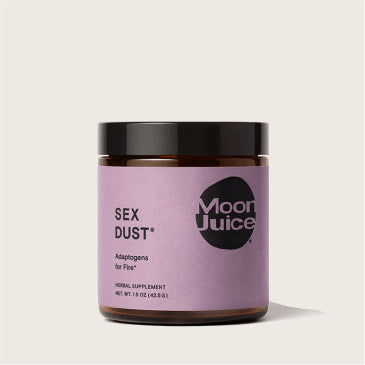How to Get Rid of Fine Lines on Your Face
Most people think aging is the main cause of lines on the face. It’s true that with time, skin can lose elasticity, contributing to wrinkle development. But lifestyle factors — like stress, diet, and sleep — also play a major role. Let’s talk about how to proactively prevent and treat fine lines, from the inside out and the outside in.
What causes lines on the face?
Skin cell turnover slows with time, leading to thinner skin that is more prone to wrinkling. And as soon as you hit your 20s, your skin starts to produce less collagen — a protein that provides structure and elasticity. Less collagen means looser skin that can contribute to facial lines. Aging also impacts your skin’s ability to absorb and retain moisture, and dryer skin can make lines more obvious.
That said, age is biological, not chronological. It’s true that natural processes can affect your skin over time and contribute to its changing appearance, but lifestyle factors also play a major role. Factors like stress, lack of sleep, toxins, and sugar can accelerate the aging process and lead to inflammaging, chronic, low-grade inflammation that can affect your overall health, skin included.
Getting too much sun exposure without wearing SPF can also take a heavy toll on your skin health.
Sun damage has a major impact on your skin health and appearance. So much so that there’s even a name for this type of damage: photoaging. UV rays don’t just cause sunburn. They can actually damage collagen fibers in your skin and cause high levels of skin-repairing enzymes called metalloproteinases. But instead of repairing collagen, sun damage causes them to do the opposite, which eventually leads to the formation of wrinkles.
Exposure to cigarette smoke and air pollution can also kick up collagen-damaging metalloproteinase levels. Smoking, nicotine specifically, can also reduce blood flow to your skin, making it tougher for nutrients to make their way to that top layer, giving it a dull appearance.
How to Get Rid of Lines on Face Without Surgery: 12 Effective Ways
If you want to know how to get rid of forehead lines and other facial wrinkles, it involves a combo of proactivity and reactivity. That means incorporating lifestyle changes and a skin care routine with targeted ingredients, while also considering treatments you can pursue.
Ingredients
Consider incorporating the following skin care ingredients and supplements into your routine to help get rid of fine lines.
Healthy Fats
One of our top skin care tips is to moisturize skin regularly. This can help curb the dryness that makes wrinkles more noticeable. Healthy dietary fat can also help minimize wrinkles and fine lines. Good fats like those found in avocados and nuts boost your skin’s moisture content from the inside, while topical products like moisturizers help hydrate from the outside. To get the most from a moisturizer, look for one with essential fatty acids
Hyaluronic Acid
Hyaluronic Acid is a popular skin care ingredient called a humectant, which hydrates and locks in moisture. This not only helps protect your skin from drying out and making lines more visible but also protects it from oxidative stress that can cause wrinkles in the first place.
One 2021 study found that participants who used a HA serum for 6 weeks saw a dramatic improvement in skin smoothness, plumpness, hydration, and fine lines.
If you are looking for a hyaluronic skin care product, check out our Plump Jelly. This hyaluronic serum on mushrooms uses low molecular weight Hyaluronic Acid and PGA Peptides working together to hydrate around the cells, coupled with Beet Amino Acid and Silver Ear Mushroom to deliver water into the cells.
Retinol
Retinoids are potent skin care miracle workers that provide some of the most effective anti-wrinkle results. Derived from Vitamin A, they have a proven track record for fighting wrinkles and winning.
Routinely using retinoids can support skin elasticity, even out skin tone, and gradually reduce wrinkles. They work by boosting cell turnovers and re-balancing free radicals, unstable molecules that cause oxidative stress. Left unchecked, free radicals and the oxidative damage they trigger can damage collagen, messing with your skin’s health and appearance.
Retinols are available over-the-counter (OTC) without a prescription. You'll need a derm prescription for the stronger stuff (AKA retinoids).
Keep in mind that both prescription and OTC forms of retinoids can cause skin irritation, especially if you have sensitive skin.
Glycolic Acid
The Alpha Hydroxy Acid (AHA) Glycolic Acid is a multi-talented skin care ingredient that can stimulate special skin cells called fibroblasts to produce collagen and break up dead skin cell bonds to make room for new ones. Increased collagen production = plumper skin with fewer fine lines. And fewer dead skin cells piling up on the top layer of skin means less debris can make skin look duller and wrinkles more apparent.
Find it in Acid Potion, a potent 25% AHA + BHA liquid exfoliant.
Collagen
Collagen slowly breaks down over time, and lifestyle factors like stress and diet can speed up the process. Knowing the best vitamins for skin tightening and maintaining a diet rich in them can ensure your body has the building blocks to produce skin-plumping collagen. But it can be tough to always eat perfectly. Adding a collagen supplement to your routine can help ensure you’re replenishing your supply.
Both oral and topical collagen can reduce and slow the signs of skin aging, according to 2022 research.
Find it in Collagen Protect® a vegan collagen powder and skin supplement to help protect and preserve your natural collagen, help elasticity, and minimize the appearance of fine lines and wrinkles.
Antioxidants
Supplements and skin care containing antioxidants like Vitamin C and E can also improve skin elasticity and nix fine lines. SuperBeauty® is our skin care capsules containing Glutathione, Vitamins C + E, and Astaxanthin to help neutralize free radicals for collagen and elasticity.
SPF
Daily use of broad-spectrum SPF is essential for healthful-looking skin. One 2016 study found that participants who used a broad-spectrum SPF 30 sunscreen on their face daily for a year experienced major skin benefits. At the end of the study, the participants had clearer, less pigmented skin and improved skin texture.
FWIW: SPF can’t treat existing wrinkles, so it’s more of a preventative ingredient.
When shopping for a sunscreen, opt for mineral instead of chemical. Mineral formulas are way gentler, especially on sensitive and acne-prone skin.
Sign Up, Nerd Out
Get wellness tips, education, and recipes
delivered straight to your inbox.
Get wellness tips, education,
and recipes delivered
straight to your inbox.
Treatments
While therapies like botox, fillers, and even surgical ones like facelifts can reduce the appearance of lines on the face, there are also several treatments you can do at home or with an esthetician or dermatologist to target and prevent lines.
Lymphatic massage
Your body’s lymphatic system is responsible for filtering toxins and preventing infection. Lymphatic massage or drainage is proven to speed up the movement and absorption of lymphatic fluids.
There’s limited evidence about the benefits of lymphatic massage in the facial area, but some therapists swear by the results, even comparing them to those of invasive facelifts.
You can get this done by a facialist but it’s also possible to do it at home with your hands or a gua sha. It involves slowly putting small amounts of downward pressure on the skin towards the lymph nodes in your neck. Think of a cat kneading a pillow, that’s the kind of gentle pressure you want to apply.
Red light therapy
Unlike skin-damaging lasers, red light therapy or RLT is a gentle therapy that doesn’t damage the skin’s outer layer. The claim is that RLT can directly affect cell mitochondria, the powerhouse of the cell that produces ATP. What does that mean for the skin? More ATP = more energy to multiply and repair — and reduce wrinkles and fine lines.
While more research is needed, some evidence suggests RLT may help boost collagen production, helping to reduce fine lines.
If you’re interested in RLT, know that you can get it with a facialist or purchase at-home face mask devices capable of emitting red light.
Microneedling
This in-office therapy has many benefits, including fine-line and wrinkle treatment. How does it work? Microneedles pierce the skin and stimulate collagen production, increasing skin firmness and elasticity.
Chemical peel
Chemical peels contain the same AHA and BHA from your go-to skin care products but in higher concentrations to peel away multiple layers of skin. Depending on the strength of the peel, you may need several days or weeks to recover. It can also take several sessions to see noticeable results, depending on your skin’s health and appearance.
Ultrasound therapy
This treatment involves using ultrasound to heat up deeper layers of skin to stimulate collagen production. It can take several months to see results since the body needs time to make new collagen. Results typically last 2 to 3 years, depending on your skin care regimen.
Sources:
Al-atif H. (2022). Collagen supplements for aging and wrinkles: A paradigm shift in the fields of dermatology and cosmetics. https://pubmed.ncbi.nlm.nih.gov/35223163/
Alpha hydroxy acids. (2022). https://www.fda.gov/cosmetics/cosmetic-ingredients/alpha-hydroxy-acids
Botulinum toxin therapy: Overview. (n.d.). https://www.aad.org/public/cosmetic/wrinkles/botulinum-toxin-overview
Chemical peels: FAQs. (n.d.). https://www.aad.org/public/cosmetic/younger-looking/chemical-peels-faqs
DePhillipo NN, et al. (2018). Efficacy of vitamin C supplementation of collagen synthesis and oxidative stress after musculoskeletal injuries: A systematic review. https://www.ncbi.nlm.nih.gov/pmc/articles/PMC6204628/
Draelos ZD, et al. (2021). Efficacy evaluation of a topical hyaluronic acid serum in facial photoaging. https://pubmed.ncbi.nlm.nih.gov/34176098/
Ezzo J, et al. (2015). Manual lymphatic drainage for lymphedema following breast cancer treatment. https://www.ncbi.nlm.nih.gov/pmc/articles/PMC4966288/
Jaros A, et al. (2019). Evaluation of selected skin parameters following the application of 5% vitamin C concentrate. https://pubmed.ncbi.nlm.nih.gov/29707883/
Lee SY, et al. (2007). A prospective, randomized, placebo-controlled, double-blinded, and split-face clinical study on LED phototherapy for skin rejuvenation: Clinical, profilometric, histologic, ultrastructural, and biochemical evaluations and comparison of three different treatment settings. https://www.sciencedirect.com/science/article/abs/pii/S1011134407000632?via%3Dihub
Lueangarun S, et al. (2019). The 24-hr, 28-day, and 7-day post-moisturizing efficacy of ceramides 1, 3, 6-II containing moisturizing cream compared with hydrophilic cream on skin dryness and barrier disruption in senile xerosis treatment. https://onlinelibrary.wiley.com/doi/10.1111/dth.13090
Many ways to firm sagging skin. (n.d.). https://www.aad.org/public/cosmetic/younger-looking/firm-sagging-skin
Microneedling can fade scars, uneven skin tone, and more. (n.d.). https://www.aad.org/public/cosmetic/scars-stretch-marks/microneedling-fade-scars
Narda M, et al. (2020). Glycolic acid adjusted to pH 4 stimulates collagen production and epidermal renewal without affecting levels of proinflammatory TNF-alpha in human skin explants. https://onlinelibrary.wiley.com/doi/10.1111/jocd.13570
Papaccio F, et al. (2022). Focus on the contribution of oxidative stress in skin aging. https://pubmed.ncbi.nlm.nih.gov/35740018/
Pullar JM, et al. (2017). The roles of vitamin C in skin health. https://www.ncbi.nlm.nih.gov/pmc/articles/PMC5579659/
Randhawa M, et al. (2016). Daily use of a facial broad spectrum sunscreen over one-year significantly improves clinical evaluation of photoaging. https://pubmed.ncbi.nlm.nih.gov/27749441/
Skin resurfacing dermabrasion. (2022). https://www.ncbi.nlm.nih.gov/books/NBK558955/
Tran D, et al. (2015). An antiaging skin care system containing alpha hydroxy acids and vitamins improves the biomechanical parameters of facial skin. https://www.ncbi.nlm.nih.gov/pmc/articles/PMC4277239/
Neill US. (2012). Skin care in the aging female: Myths and truths. https://www.ncbi.nlm.nih.gov/pmc/articles/PMC3266803/
What are fillers? (n.d.). https://www.aad.org/public/cosmetic/wrinkles/fillers-overview
What is laser skin resurfacing? (n.d.). https://www.plasticsurgery.org/cosmetic-procedures/laser-skin-resurfacing
Wunsch A, et al. (2014). A Controlled Trial to Determine the Efficacy of Red and Near-Infrared Light Treatment in Patient Satisfaction, Reduction of Fine Lines, Wrinkles, Skin Roughness, and Intradermal Collagen Density Increase. https://www.ncbi.nlm.nih.gov/pmc/articles/PMC3926176/
Zasada M, et al. (2020). A clinical anti-ageing comparative study of 0.3 and 0.5% retinol serums: A clinically controlled trial. https://pubmed.ncbi.nlm.nih.gov/32428912/
Zhang S, et al. (2018). Fighting against skin aging: The way from bench to bedside. https://journals.sagepub.com/doi/10.1177/0963689717725755
Sources
- Al-atif H. (2022). Collagen supplements for aging and wrinkles: A paradigm shift in the fields of dermatology and cosmetics. https://pubmed.ncbi.nlm.nih.gov/35223163/
- Alpha hydroxy acids. (2022). https://www.fda.gov/cosmetics/cosmetic-ingredients/alpha-hydroxy-acids
- Botulinum toxin therapy: Overview. (n.d.). https://www.aad.org/public/cosmetic/wrinkles/botulinum-toxin-overview
- Chemical peels: FAQs. (n.d.). https://www.aad.org/public/cosmetic/younger-looking/chemical-peels-faqs
- DePhillipo NN, et al. (2018). Efficacy of vitamin C supplementation of collagen synthesis and oxidative stress after musculoskeletal injuries: A systematic review. https://www.ncbi.nlm.nih.gov/pmc/articles/PMC6204628/DePhillipo NN, et al. (2018). Efficacy of vitamin C supplementation of collagen synthesis and oxidative stress after musculoskeletal injuries: A systematic review. https://www.ncbi.nlm.nih.gov/pmc/articles/PMC6204628/
- Draelos ZD, et al. (2021). Efficacy evaluation of a topical hyaluronic acid serum in facial photoaging. https://pubmed.ncbi.nlm.nih.gov/34176098/
- Ezzo J, et al. (2015). Manual lymphatic drainage for lymphedema following breast cancer treatment. https://www.ncbi.nlm.nih.gov/pmc/articles/PMC4966288/
- Jaros A, et al. (2019). Evaluation of selected skin parameters following the application of 5% vitamin C concentrate. https://pubmed.ncbi.nlm.nih.gov/29707883/
- Lee SY, et al. (2007). A prospective, randomized, placebo-controlled, double-blinded, and split-face clinical study on LED phototherapy for skin rejuvenation: Clinical, profilometric, histologic, ultrastructural, and biochemical evaluations and comparison of three different treatment settings. https://www.sciencedirect.com/science/article/abs/pii/S1011134407000632?via%3Dihub
- Lueangarun S, et al. (2019). The 24-hr, 28-day, and 7-day post-moisturizing efficacy of ceramides 1, 3, 6-II containing moisturizing cream compared with hydrophilic cream on skin dryness and barrier disruption in senile xerosis treatment. https://onlinelibrary.wiley.com/doi/10.1111/dth.13090
- Many ways to firm sagging skin. (n.d.). https://www.aad.org/public/cosmetic/younger-looking/firm-sagging-skin
- Microneedling can fade scars, uneven skin tone, and more. (n.d.). https://www.aad.org/public/cosmetic/scars-stretch-marks/microneedling-fade-scars
- Narda M, et al. (2020). Glycolic acid adjusted to pH 4 stimulates collagen production and epidermal renewal without affecting levels of proinflammatory TNF-alpha in human skin explants. https://onlinelibrary.wiley.com/doi/10.1111/jocd.13570
- Papaccio F, et al. (2022). Focus on the contribution of oxidative stress in skin aging. https://pubmed.ncbi.nlm.nih.gov/35740018/
- Pullar JM, et al. (2017). The roles of vitamin C in skin health. https://www.ncbi.nlm.nih.gov/pmc/articles/PMC5579659/
- Randhawa M, et al. (2016). Daily use of a facial broad spectrum sunscreen over one-year significantly improves clinical evaluation of photoaging. https://pubmed.ncbi.nlm.nih.gov/27749441/
- Skin resurfacing dermabrasion. (2022). https://www.ncbi.nlm.nih.gov/books/NBK558955/
- Tran D, et al. (2015). An antiaging skin care system containing alpha hydroxy acids and vitamins improves the biomechanical parameters of facial skin. https://www.ncbi.nlm.nih.gov/pmc/articles/PMC4277239/
- Neill US. (2012). Skin care in the aging female: Myths and truths. https://www.ncbi.nlm.nih.gov/pmc/articles/PMC3266803/
- What are fillers? (n.d.). https://www.aad.org/public/cosmetic/wrinkles/fillers-overview
- What is laser skin resurfacing? (n.d.). https://www.plasticsurgery.org/cosmetic-procedures/laser-skin-resurfacing
- Wunsch A, et al. (2014). A Controlled Trial to Determine the Efficacy of Red and Near-Infrared Light Treatment in Patient Satisfaction, Reduction of Fine Lines, Wrinkles, Skin Roughness, and Intradermal Collagen Density Increase. https://www.ncbi.nlm.nih.gov/pmc/articles/PMC3926176/
- Zasada M, et al. (2020). A clinical anti-ageing comparative study of 0.3 and 0.5% retinol serums: A clinically controlled trial. https://pubmed.ncbi.nlm.nih.gov/32428912/
- Zhang S, et al. (2018). Fighting against skin aging: The way from bench to bedside. https://journals.sagepub.com/doi/10.1177/0963689717725755











